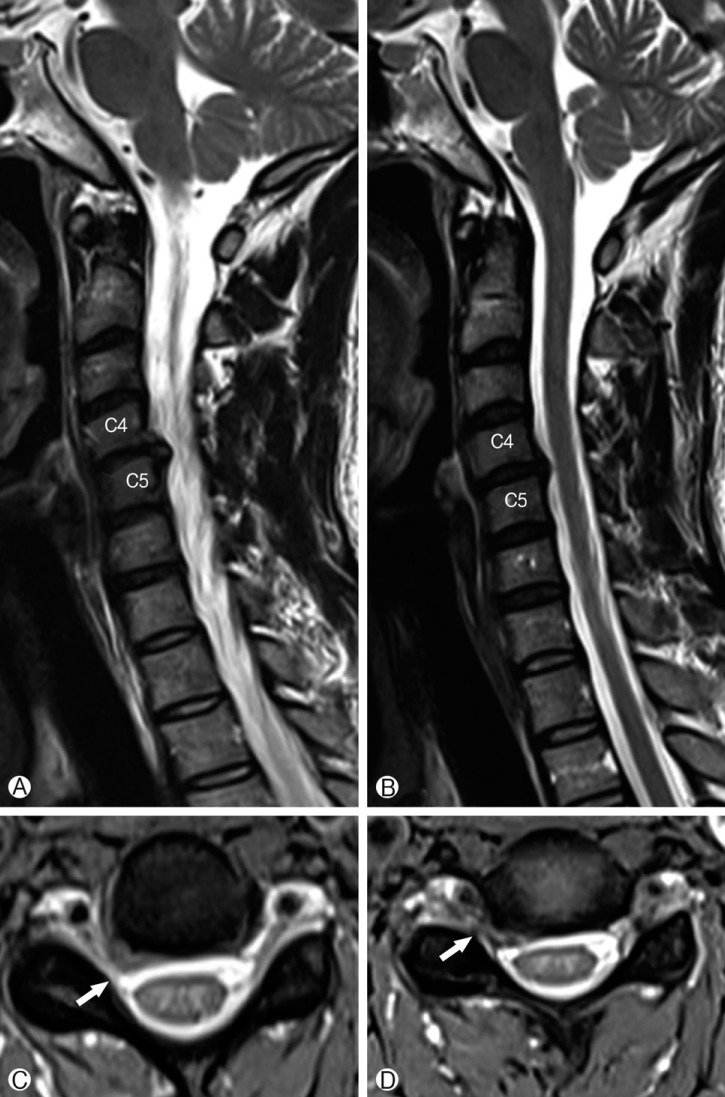 |
 |
- Search
Abstract
Spontaneous regression of cervical disc herniation is a rare, and such reports are few. A 39 year-old woman complained of severe neck pain associated with tingling and numbness of right upper extremity. The MRI of the cervical spine revealed a posterior disc extrusion at the C4-C5 level in the right para-central location. The patient was treated with conservative management without any surgical treatment. The patient's symptoms were significant improvement. After two years later, we performed follow-up cervical MRI that revealed significant spontaneous regression of the C4-C5 intervertebral disc extrusion.
Spontaneous regression of herniated lumbar disc has been has been well established3,7). However, spontaneous regression of herniated cervical disc is rarely reported3,7,8). Recent advances in magnetic resonance imaging (MRI) have facilitated follow-up of intervertebral disc herniation and prospect spontaneous regression1,8). We present a case of spontaneous regression of cervical disc herniation who treated conservative management without any surgical treatment and review related literatures.
A 39 year-old woman presented with severe neck pain associated with tingling sensation and numbness of right upper extremity that developed 3 months ago. Her neurologic examinations revealed no motor weakness but hypoesthesia right C4 and C5 dermatome. All reflex brisk and symmetric. The plain radiographs of the cervical spine revealed no abnormality. The MRI of the cervical spine was done, which showed a posterior disc extrusion at the C4-C5 level in the right paracentral location (Fig. 1). Conservative management was given in the form of non-steroidal-anti-inflammatory drugs and a muscle relaxant. The patient also received multiple sessions of physical therapy. After 3 weeks treatment, the patient's symptoms were significant improvement. After two years later, she re-visited our hospital because of developed neck pain recently. We performed follow-up cervical MRI that revealed significant spontaneous regression of the C4-C5 intervertebral disc extrusion (Fig. 2). The patient's symptoms were alleviated spontaneously
after 2 weeks.
The mechanism of spontaneous regression disc herniation is still unclear. Many factors related to the resorption process have been recognized1). The type of disc herniation is more contributable to spontaneous disc regression than the size of disc herniation6). Spontaneous regression of herniated disc was seen more frequently in extruded disc than protruded disc7). In general, large-sized herniated disc have been observed to regress more than smaller one4,8), and a sequestrated-type disc herniation is likely to regress more readily than a protruded disc8). Extrusion and sequestrated disc into the epidural space induces an inflammatory cascade involving neovascularization and phagocytosis that may lead to disc regression5,6,8).
Burke et al.2) reported that the human disc tissue is capable of spontaneously producing the pro-inflammatory chemokines monocyte chemo-attractant such as protein-1 and interleukin-8. The chemo-attractants are suspected of initiating an inflammatory recruitment of monocytes from the nearby blood supply. Chemotactic for macrophages and capillaries may explain the ingrowth of granulation tissue seen in spontaneous disc herniation resorption.
Autio et al.1) reported that a gadolinium-diethylenetriamine pentaacetic acid (Gd-DTPA) enhanced MRI to evaluate the neovascularization zone and to predict the possibility of spontaneous regression of herniated disc. The extent of peripheral enhancement tends to be greater in sequestration type herniation when compared to bulging or protruding herniation4). They suggested that neovascularization in the outermost areas of herniated disc, presenting as an enhancing rim in Gd-DTPA MRI, is thought to be a major determinant of spontaneous regression of herniated disc1) and thickness of rim enhancement was a stronger determinant of spontaneous regression than extent of rim enhancement also1).
Kobayashi et al.6) reported a case of herniated cervical disc that showed partial spontaneous regression on follow-up MRI after 3 weeks and complete spontaneous regression on follow-up MRI after 12 months. They also reviewed previous reported 6 cases of spontaneous regression in herniated cervical disc. In their report, spontaneous regression took 2 to 28 months. Mean age was 39.8 (ranged from 31 to 50). All patients showed extruded herniated disc type. Our case is similar with these reported cases.
References
1. Autio RA, Karppinen J, Niinimäki J, Ojala R, Kurunlahti M, Haapea M, et al. Determinants of spontaneous resorption of intervertebral disc herniations. Spine (Phila Pa 1976) 2006 31(11):1247-1252. PMID: 16688039.


2. Burke JG, Watson RW, McCormack D, Dowling FE, Walsh MG, Fitzpatrick JM. Spontaneous production of monocyte chemoattractant protein-1 and interleukin-8 by the human lumbar intervertebral disc. Spine (Phila Pa 1976) 2002 27(13):1402-1407. PMID: 12131736.


3. Gurkanlar D, Yucel E, Er U, Keskil S. Spontaneous regression of cervical disc herniations. Minim Invasive Neurosurg 2006 49(3):179-183. PMID: 16921460.


4. Kim ES, Oladunjoye AO, Li JA, Kim KD. Spontaneous regression of herniated lumbar discs. J Clin Neurosci 2014 21(6):909-913. PMID: 24316264.


5. Kim KD, Kim ES. Unknown case: part 2. Spontaneous regression of herniated disc. Spine (Phila Pa 1976) 2013 38(4):368PMID: 22089402.


6. Kim SG, Yang JC, Kim TW, Park KH. Spontaneous regression of extruded lumbar disc herniation: three cases report. Korean J Spine 2013 10(2):78-81. PMID: 24757463.



7. Kobayashi N, Asamoto S, Doi H, Ikeda Y, Matusmoto K. Spontaneous regression of herniated cervical disc. Spine J 2003 3(2):171-173. PMID: 14589234.


8. Orief T1, Orz Y, Attia W, Almusrea K. Spontaneous resorption of sequestrated intervertebral disc herniation. World Neurosurg 2012 77(1):146-152. PMID: 22154147.



- TOOLS
-
METRICS

-
- 6 Crossref
- Scopus
- 9,514 View
- 91 Download
- Related articles in NS
-
Sudden Paraplegia Caused by Nontraumatic Cervical Disc Rupture: A Case Report2017 December;14(4)
Total Cervical Disc Replacement using Artificial Disc in Cervical Disc Herniations.2008 March;5(1)
Spontaneous Resolution of Spinal Epidural Hematoma: A Case Report.2008 June;5(2)
Atypical Presentation of Cervical 3-4 Disc Herniation - A Case Report -2007 June;4(2)
-
Journal Impact Factor 3.2



























